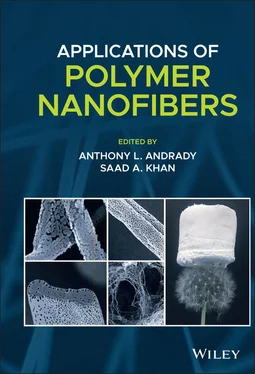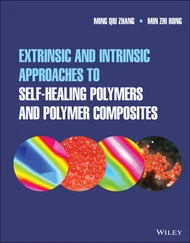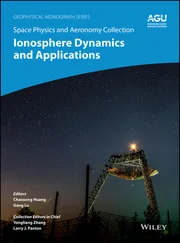Applications of Polymer Nanofibers
Здесь есть возможность читать онлайн «Applications of Polymer Nanofibers» — ознакомительный отрывок электронной книги совершенно бесплатно, а после прочтения отрывка купить полную версию. В некоторых случаях можно слушать аудио, скачать через торрент в формате fb2 и присутствует краткое содержание. Жанр: unrecognised, на английском языке. Описание произведения, (предисловие) а так же отзывы посетителей доступны на портале библиотеки ЛибКат.
- Название:Applications of Polymer Nanofibers
- Автор:
- Жанр:
- Год:неизвестен
- ISBN:нет данных
- Рейтинг книги:4 / 5. Голосов: 1
-
Избранное:Добавить в избранное
- Отзывы:
-
Ваша оценка:
- 80
- 1
- 2
- 3
- 4
- 5
Applications of Polymer Nanofibers: краткое содержание, описание и аннотация
Предлагаем к чтению аннотацию, описание, краткое содержание или предисловие (зависит от того, что написал сам автор книги «Applications of Polymer Nanofibers»). Если вы не нашли необходимую информацию о книге — напишите в комментариях, мы постараемся отыскать её.
Explore a comprehensive review of the practical experimental and technological details of polymer nanofibers with a leading new resource Applications of Polymer Nanofibers
Applications of Polymer Nanofibers
Applications of Polymer Nanofibers
Applications of Polymer Nanofibers — читать онлайн ознакомительный отрывок
Ниже представлен текст книги, разбитый по страницам. Система сохранения места последней прочитанной страницы, позволяет с удобством читать онлайн бесплатно книгу «Applications of Polymer Nanofibers», без необходимости каждый раз заново искать на чём Вы остановились. Поставьте закладку, и сможете в любой момент перейти на страницу, на которой закончили чтение.
Интервал:
Закладка:
Nataliya FedorovaThe Nonwovens Institute NC State University Raleigh, NC USA
Yeqian GeWilson College of Textiles North Carolina State University Fiber and Science Program Raleigh, NC USA
Vibha KalraDepartment of Chemical and Biological Engineering Drexel University Philadelphia, PA USA
Saad A. KhanDepartment of Chemical and Biomolecular Engineering North Carolina State University Raleigh, NC USA
Irene S. KurtzDepartment of Chemical Engineering University of Massachusetts Amherst Amherst, MA USA
Shani L. LevitDepartment of Chemical and Life Science Engineering Virginia Commonwealth University Richmond, VA USA
Benoit MazeThe Nonwovens Institute NC State University Raleigh, NC USA
Bharadwaja S.T. PeddintiDepartment of Chemical and Biomolecular Engineering North Carolina State University Raleigh, NC USA
Tahira PirzadaDepartment of Chemical and Biomolecular Engineering North Carolina State University Raleigh, NC USA
Behnam PourdeyhimiThe Nonwovens Institute NC State University Raleigh, NC USA
Vahid RahmanianDepartment of Chemical and Biomolecular Engineering North Carolina State University Raleigh, NC USA
Kristen E. RoskovDepartment of Chemical and Biomolecular Engineering North Carolina State University Raleigh, NC USA and BASF Agricultural Solutions BASF Corporation Research Triangle Park, NC USA
Jessica D. SchiffmanDepartment of Chemical Engineering University of Massachusetts Amherst Amherst, MA USA
Richard J. SpontakDepartment of Chemical and Biomolecular Engineering North Carolina State University Raleigh, NC USA and Department of Materials Science and Engineering North Carolina State University Raleigh, NC USA
Xiaoyu SunDepartment of Chemical and Biomolecular Engineering North Carolina State University Raleigh, NC USA and Integrated Diagnostic Solutions Becton Dickinson & Company Franklin Lakes, NJ USA
Kathleen F. SwanaU.S. Army Combat Capabilities Development Command Soldier Center Natick, MA USA
Christina TangDepartment of Chemical and Life Science Engineering Virginia Commonwealth University Richmond, VA USA
Breland T. ThorntonDepartment of Chemical and Life Science Engineering Virginia Commonwealth University Richmond, VA USA
Tamer UyarDepartment of Fiber Science & Apparel Design College of Human Ecology Cornell University Ithaca, NY, 14853 USA
Howard J. WallsAerosol Control Group Lead Technology Advancement & Commercialization RTI International Research Triangle Park, NC, 27709‐2194 USA
Xiangwu ZhangWilson College of Textiles North Carolina State University Fiber and Science Program Raleigh, NC USA
Jiadeng ZhuWilson College of Textiles North Carolina State University Fiber and Science Program Raleigh, NC USA
Preface
The origins of electrospinning technology dates back to the days when Jean‐Antoine Nollett first electrosprayed water with an electric charge generated from a Leyden Jar, back in 1746. But it was not until 1902 that Cooley filed the first patent on electrospinning based on that process. It took yet another half a century before Geoffrey Taylor in 1969 modeled the deformation of a liquid droplet in an electric field as the Taylor's cone. Electrospinning of nanofibers has come a long way since then, thanks to the intensive burst of research since the 1990s when academia got interested in the process. Today, it is a popular and versatile technology with several books published on electrospinning in recent years, including The Science and Technology of Polymer Nanofibers (Wiley 2008) by one of the present editors. Nanofiber science has made impressive advances and recently discovered a myriad of applications for this unique nanomaterial. Most of these developments occurred during the last two to three decades of research; the term “electrospinning” itself came into common use only as recently as 1995. Among the many different routes to fabricating nanofibers, electrospinning remains the most popular because of its simplicity, low‐cost, and scalability. By definition, nanofibers are 1‐D nanomaterials that have diameterd <100 nm. While there is scientific and regulatory agreement on this size range, many research publications as well as some regulatory organizations accommodate an upper limit of a d = 1000 nm. Electrospinning is able to fabricate nanofibers that fall within both size ranges.
The singular property that makes nanofibers so useful is their very high specific surface area. For instance, at a fiber diameter of 500 nm, the surface area per gram of resin can reach a 1000 m 2that is larger than the floor area of two basketball courts. Compared to other nanogeometries such as thin films, this allows for relatively faster interaction of nanofibers with chemicals, particles, or live cells in applications such as chemical sensors, high‐efficiency filters, biomedical scaffolding applications, and faster release of bioactive compounds in controlled‐release applications. Sub‐100 nm nanofibers, such as those of carbon, display unique quantum size effects, obtain exceptional strength, and high conductivity. Spider drag‐line silk 1 , naturally occurring nanofibers that are ~20 nm in size diameter, display a tensile modulus of 10.6 (GPa) at 25% RH. Optimized nanofibers for specific applications are usually doped with other molecules, coated with an active material or might be a nanofilled composite material. Also, electrospun fiber mats allow easy handling of the nanofibers in different application and their high porosity helps easier access of reactants to fiber surface functionalities. Industrially relevant nanofiber materials fall into four broad classes: (i) carbon nanofibers; (ii) polymer nanofibers; (iii) inorganic nanofibers; and (iv) composite nanofibers. All four classes of these can be made in the laboratory by electrospinning of a composition where the crucial component for fiber‐forming is a polymer. Over 50 different types of polymers have been electrospun up to date, and it is safe to assume that conditions allowing electrospinning of almost any polymer can be identified. Incorporating oxides, especially ZnO, TiO 2, SnO 2, and Al 2·O 3in nanofibers has been reported in nanofibers in recent literature.
The promise of nanofibers as a particularly useful material of the future is justified because of several observations. The first has to do with the incredible diversity of nanofiber morphologies fabricated under careful conditions. These include exotic configurations including multichannel fibers where the lacuna is divided into two to five sections, tube in tube nanofibers, core–shell nanofibers, nanowire in nanotube structures, and nanodots synthesized at junctions where nanofibers overlap in a mat. A second observation is the advancement in large‐scale nanofiber manufacture. Development of flexible nanofiber mats that might be integrated into fabric to support efforts at developing wearable electronics is under way. Innovations of nanofibers in textile science are discussed in Chapter 2. Large‐scale fabrication of nanofiber mats using electrodeless systems such as already‐ commercialized Nanospider™ (ElMarco) will further advance to bring down the cost of the material. Chapter 5reviews the status of commercial production of nanofibers.
Nanofiber mats are porous with up to 90% of the volume being void spaces and their average pore diameters are less than about ten times the fiber diameter. Because of these features the mats are highly permeable and can be readily adapted for air filtration. Multilayer filter media with one layer being made of nanofiber mats has already been commercialized. Applications of nanofibers in filtration are discussed in Chapter 3. Even more porous nanofiber materials are made of aerogel materials, a class of nanomaterials that shows promise in several of the application areas as discussed in Chapter 9. Nanofibers significantly contribute to innovation in medical technology, specifically in tissue engineering, wound healing and controlled release applications. Nanofibers have a large surface area to volume ratio and can be fabricated with biodegradable polymers compatible with body tissue, mimicking protein fibrils or the chemical structure of native extracellular matrix as well as synthetic ‘protein’ nanofibers of polyamino acids. Chapters 6and 7discuss their biomedical uses, including tissue scaffolding by nanofibers that can also serve as highly compatible implantable materials. An especially interesting application in the biomedical aren a is controlled delivery of bioactive agents such as proteins and DNA. Successful DNA delivery with nanofibers holds the possibility of its use a as a vehicle for clinically relevant gene‐delivery in genomic treatment modes. A third related area is biological sensors based on nanofiber materials with the surface functionalized to specifically interact with a biomolecule. The reaction with the biomolecule results in a physical or chemical change in the fiber that allows the quantification of its concentration in terms of a change in fluorescence or conductivity of the fiber mat. Chapter 4discusses the use of nanofibers in sensor technology. Nanofibers are finding uses in energy technology, especially in battery, fuel cell, and solar energy. Chapter 5of the book reviews these developments.
Читать дальшеИнтервал:
Закладка:
Похожие книги на «Applications of Polymer Nanofibers»
Представляем Вашему вниманию похожие книги на «Applications of Polymer Nanofibers» списком для выбора. Мы отобрали схожую по названию и смыслу литературу в надежде предоставить читателям больше вариантов отыскать новые, интересные, ещё непрочитанные произведения.
Обсуждение, отзывы о книге «Applications of Polymer Nanofibers» и просто собственные мнения читателей. Оставьте ваши комментарии, напишите, что Вы думаете о произведении, его смысле или главных героях. Укажите что конкретно понравилось, а что нет, и почему Вы так считаете.












